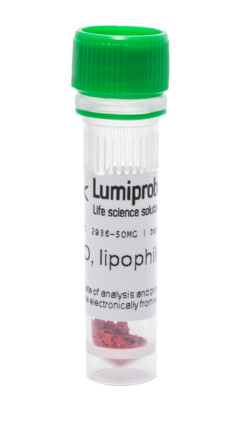DiO, lipophilic tracer
| Cat. # | Quantity | Price | Lead time | Buy this product |
|---|---|---|---|---|
| 2936-1mg | 1 mg |
–
|
in stock | |
| 2936-5mg | 5 mg |
$24
|
in stock | |
| 2936-50mg | 50 mg |
$223
|
5 days |

DiO, also called DiOC18(3), is a green fluorescent, lipophilic carbocyanine dye. DiO’s excitation max. at 487 nm, and emission max. at 501 nm.
DiO is widely used as an anterograde and retrograde neuronal tracer in living and fixed tissues and cells. DiO uniformly labels neurons via diffusion in the plasma membrane. In intact tissue, the dye does not transfer from labeled to unlabeled cells but some transfer may occur when the membrane is disrupted, for example after sectioning.
DiO and DiI are often used together in dual-color studies. But DiO has a slower lateral diffusion rate on the membranes than that of DiI.
Absorption and emission spectra of DiO

Customers also purchased with this product
General properties
| Appearance: | orange solid |
| Molecular weight: | 782.27 |
| CAS number: | 28462-56-8 |
| Molecular formula: | C53H85N2O2 |
| Solubility: | DMSO |
| Quality control: | NMR 1H and HPLC-MS (95+%) |
| Storage conditions: | 24 months after receival at -20°C in the dark. Transportation: at room temperature for up to 3 weeks. Desiccate. |
| MSDS: | Download |
| Product specifications |
Spectral properties
| Excitation/absorption maximum, nm: | 487 |
| ε, L⋅mol−1⋅cm−1: | 102000 |
| Emission maximum, nm: | 501 |
| Fluorescence quantum yield: | 0.51 |

























 $
$ 
